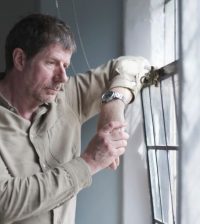- USDA Gets Tougher on Salmonella in Raw Breaded Chicken Products
- Fragments of Bird Flu Virus Found in 1 in 5 Milk Samples
- Clients Got HIV Through ‘Vampire Facial’ Microneedling Treatments
- Take the Stairs & Step Up to Longer Life
- ‘Drug Take Back Day’ is Saturday: Check for Leftover Opioids in Your Home
- Loneliness Can Shorten Lives of Cancer Survivors
- A Stolen Dog Feels Like Losing a Child, Study Finds
- Healthier Hearts in Middle Age Help Black Women’s Brains Stay Strong
- Better Scans Spot Hidden Inflammation in MS Patients
- Which Patients and Surgeries Are ‘High Risk’ for Seniors?
Health Highlights: Dec. 2, 2014


Here are some of the latest health and medical news developments, compiled by the editors of HealthDay:
Obama to Focus on Ebola Vaccine Research in NIH Visit
Advances in efforts to develop a safe and effective Ebola vaccine will be highlighted by President Barack Obama during his visit Tuesday to the National Institutes of Health.
It’s also expected that the president will push for Congress to approve his request for $6.2 billion to fight Ebola in other countries and to prevent its spread in the United States, the Associated Press reported.
Lawmakers should “take prompt action on this,” according to White House spokesman Josh Earnest.
Last week, American researchers released a study saying an experimental Ebola vaccine seems safe and triggered immune protection in volunteers, the AP reported.
——
Guinea and Liberia Achieve Ebola Containment Goals: WHO
Guinea and Liberia have met the World Health Organization’s Dec. 1 target for isolating 70 percent of Ebola patients and safely burying 70 percent of those who die from the disease.
However, Sierra Leone did not achieve those objectives, the WHO said Monday, the Associated Press reported.
Last week, the WHO said Guinea was the only one of the three hardest-hit West African nations on track to meet the targets, which were announced two months ago.
Since then, “tremendous progress” has been made in slowing the spread of the deadly disease, and the next 60 days will be crucial, according to U.N. Ebola chief David Nabarro, the AP reported.
The first cases of Ebola were reported in March and the outbreak was declared a public health emergency in August. More than 16,000 people have been sickened and nearly 7,000 of them have died.
Ebola cases appear to be falling or stabilizing in Liberia and Guinea in recent weeks. But there has been a spike in cases around Sierra Leone’s capital and a district in the country’s north, the AP reported.
WHO’s failure to meet its Dec. 1 targets suggests the outbreak could widen as resources become even more stretched, according to an expert.
“We need to redouble our efforts to see what we can do to reduce the spread and catch up with the virus. Right now, it doesn’t look good,” Oyewale Tomori, of Redeemer’s University in Nigeria, who sits on WHO’s Emergency Ebola committee, told the AP.
However, other experts suggest the WHO’s Dec. 1 targets weren’t significant.
“You want to isolate 100 percent of patients with Ebola and have 100 percent safe burials,” Sebastian Funk, director of the Centre for the Mathematical Modeling of Infectious Diseases at the London School of Hygiene and Tropical Medicine, told the AP. “Getting to 70 percent doesn’t really mean a lot.”
By Jan. 1, the WHO wants to isolate all Ebola patients and have safe burials for all victims.
“We hope that what we’re seeing in Liberia will continue, but unfortunately what can happen with Ebola is that it can go to new countries, as it has already to Mali,” Dr. David Heymann, an Ebola expert who previously worked for the WHO, told the AP.
“The most dangerous thing would be if people now think Ebola is over and become complacent,” he added.
Pointing to a decline in cases, the United States recently announced it was reducing the size and number of Ebola clinics it had initially pledged to build in Liberia, the AP reported.
Copyright © 2024 HealthDay. All rights reserved.









